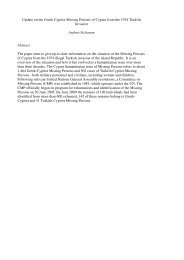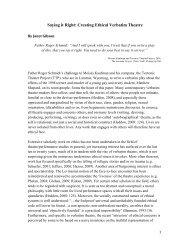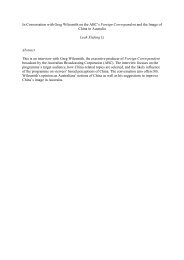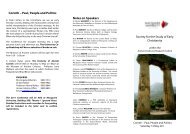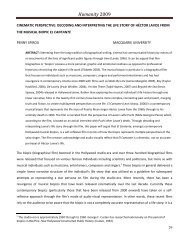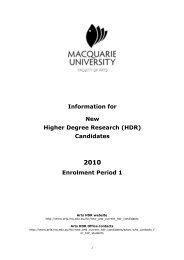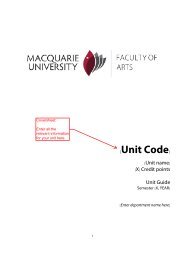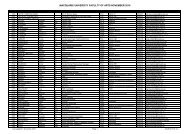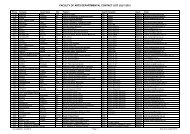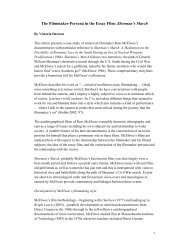'Glocal' Big Brother phenomenon in Thailand
'Glocal' Big Brother phenomenon in Thailand
'Glocal' Big Brother phenomenon in Thailand
You also want an ePaper? Increase the reach of your titles
YUMPU automatically turns print PDFs into web optimized ePapers that Google loves.
1<br />
‘Glocal’ <strong>Big</strong> <strong>Brother</strong> Phenomenon <strong>in</strong> <strong>Thailand</strong><br />
By Noparat Tananuraksakul<br />
The enterta<strong>in</strong>ment <strong>in</strong>dustry is lucrative and flourish<strong>in</strong>g ow<strong>in</strong>g to advancements <strong>in</strong><br />
modern technology. Television, <strong>in</strong> particular, penetrates homes <strong>in</strong> almost every<br />
corner of the world. The current trend of reality-based TV shows <strong>in</strong> the West has<br />
proven to be a phenomenal success and prompted Asian TV <strong>in</strong> 2005 to adapt and<br />
create its own version of the popular <strong>in</strong>ternational series <strong>Big</strong> <strong>Brother</strong> – <strong>Big</strong> <strong>Brother</strong><br />
<strong>Thailand</strong>. The show drew large audiences and was such a hit that its producers, the<br />
Kantana Group, immediately produced a second series <strong>in</strong> the follow<strong>in</strong>g year.<br />
This paper explores the <strong>phenomenon</strong> of a ‘glocal’ television program <strong>in</strong> <strong>Thailand</strong> - the<br />
first and second <strong>Big</strong> <strong>Brother</strong> <strong>Thailand</strong> series - exam<strong>in</strong><strong>in</strong>g the ways <strong>in</strong> which audiences<br />
view and <strong>in</strong>terpret the shows, both <strong>in</strong> terms of passive and active reception, via<br />
positive (identification) and negative (<strong>in</strong>dignation). Responses from local and<br />
expatriate viewers vary, with some approv<strong>in</strong>g of the behaviour of housemates,<br />
<strong>in</strong>clud<strong>in</strong>g gestures, and others f<strong>in</strong>d<strong>in</strong>g these <strong>in</strong>appropriate and <strong>in</strong>sult<strong>in</strong>g. Lead<strong>in</strong>g Thai<br />
commentators, however, have unanimously condemned the shows, question<strong>in</strong>g their<br />
propensity to promote ‘unThai’ behaviours that have the potential to corrupt the Thai<br />
social fabric. The <strong>in</strong>fluence of these critics caused the show’s producers to be called<br />
before the House Committee on Religion, Arts and Culture <strong>in</strong> 2005 – publicity about<br />
which caused the program’s rat<strong>in</strong>gs to peak. This paper exam<strong>in</strong>es the range of<br />
responses to <strong>Big</strong> <strong>Brother</strong> <strong>Thailand</strong> and raises the question of whether glocal television<br />
programs benefit local communities by <strong>in</strong>creas<strong>in</strong>g global understand<strong>in</strong>g and<br />
communication or contribute to the water<strong>in</strong>g down of local cultures <strong>in</strong> favour of<br />
global hegemony.<br />
Introduction<br />
TV and Internet globalisation, emerg<strong>in</strong>g <strong>in</strong> the latter part of 20th century, has had a<br />
great <strong>in</strong>fluence on almost all nations, <strong>in</strong> terms of economics, politics and culture.<br />
Culturally, the media has provided people with a popular way to relax, socialize, ga<strong>in</strong><br />
knowledge and even improve family ties. The adoption and use of new and advanced<br />
media communication technologies by contemporary societies has contributed to the<br />
constitution of a globally political and economic system, where each <strong>in</strong>dividual and<br />
each nation state complexly depends on and connects with another (Alasuutari, 1999).<br />
Television contributes directly to this transformation of the world <strong>in</strong>to a global<br />
<strong>phenomenon</strong>. Giddens (1999) sees globalism as compris<strong>in</strong>g a place where no s<strong>in</strong>gle<br />
entity is capable of dom<strong>in</strong>ation or imperialism. Some commentators see the global<br />
world as a place where diverse groups of people from different nations can connect<br />
and exchange both cultures and ideas (Morley & Rob<strong>in</strong>s, 1995). McLuhan (1964)<br />
argued that understand<strong>in</strong>g and empathy are brought to citizens of the global village.<br />
However, globalisation also has its critics. Ritzier (1993) views the world under<br />
globalisation as marred by hegemony, where citizens of the global state are passively<br />
moulded <strong>in</strong>to one dom<strong>in</strong>ant culture and misled to los<strong>in</strong>g <strong>in</strong>dividual identity. On the<br />
one hand, Internet users can search for <strong>in</strong>formation onl<strong>in</strong>e, trade products and<br />
services, and use electronic mails and <strong>in</strong>stant messages to communicate with others
2<br />
across the globe. On the other hand, at anytime and <strong>in</strong> any place, television audiences<br />
are drawn <strong>in</strong>to watch<strong>in</strong>g programs produced for global distribution because local<br />
producers may have limited budgets to make their own products (Wilson, 2004).<br />
Additionally, <strong>in</strong> many cases the costs of purchas<strong>in</strong>g programs from the USA and<br />
Western Europe are much lower than hav<strong>in</strong>g to locally produce them (Berger, 1992).<br />
Yet, viewers, not only <strong>in</strong> different cultures and societies but also <strong>in</strong> the same society,<br />
<strong>in</strong>terpret the programs <strong>in</strong> dissimilar ways. When audiences view programs, they give<br />
their own mean<strong>in</strong>gs to them by culturally <strong>in</strong>terpret<strong>in</strong>g the product communication<br />
through active participation - “the bottom-up flow of <strong>in</strong>terpretations of people liv<strong>in</strong>g<br />
<strong>in</strong> a geographical sett<strong>in</strong>g” (Lie, 2003: 109). Höijer (1999) refers to them as active<br />
audiences who use the cultural <strong>in</strong>terpretation flow to strengthen their social, cultural<br />
and political engagements, whereas Fisk (1987, 1991) and Curran (2006) see such<br />
flows as audience power that protects people from undesired ideology.<br />
In consequence, the term ‘glocalisation’ - or ‘localisation’ of the globe – has been<br />
co<strong>in</strong>ed to reflect the merg<strong>in</strong>g of the concepts - ‘global’ and ‘local’. For Barker<br />
(1999), global products can become local as whatever is considered local “is produced<br />
with<strong>in</strong> and by a globalis<strong>in</strong>g discourse which <strong>in</strong>cludes capitalist market<strong>in</strong>g and its<br />
<strong>in</strong>creas<strong>in</strong>g orientation to differentiated local markets” (p. 42). Chang (2003) def<strong>in</strong>es<br />
media glocalisation as “a language-block-by-language-block approach or country-bycountry<br />
approach to deal with differences with<strong>in</strong> a region” (p. 4) that <strong>in</strong>volves three<br />
phases of programm<strong>in</strong>g strategies. The first one refers to re-broadcast<strong>in</strong>g Western<br />
programm<strong>in</strong>g; the second <strong>in</strong>volves the customis<strong>in</strong>g of language; the third recognises<br />
the cooperation of <strong>in</strong>ternational producers with local sectors for local programm<strong>in</strong>g.<br />
It is evident that glocal products or commodities are more likely to orig<strong>in</strong>ate from<br />
Western countries, specifically the United States, the so-called locus of modernity.<br />
The products are usually wrapped up <strong>in</strong> glossy packages, attract<strong>in</strong>g consumers<br />
elsewhere who either <strong>in</strong>tegrate or dis<strong>in</strong>tegrate themselves with the packages, such<br />
<strong>in</strong>tegration and dis<strong>in</strong>tegration depend<strong>in</strong>g on the forms of consumers’ familiarity or<br />
unfamiliarity with the cultural identity of the product. Referred to by Wang and<br />
Servaes (2002) as <strong>in</strong>volv<strong>in</strong>g paired aspects, this process depends on one’s <strong>in</strong>ward<br />
feel<strong>in</strong>gs of identification with a particular culture or subculture and an outward<br />
tendency towards or away from another culture <strong>in</strong> order to come to a realisation of a<br />
sense of cultural differences from and similarities to others. The sense of viewer<br />
identity is also associated with a process of “learn<strong>in</strong>g about and accept<strong>in</strong>g the<br />
traditions, heritage, language, religion, ancestry, aesthetics, th<strong>in</strong>k<strong>in</strong>g patterns, and<br />
social structures of a culture” (Lust<strong>in</strong>g & Koester, 2006: 137). Among these cultural<br />
values, as described by Samovar and Porter (2003), are powerful guides of one’s own<br />
perceptions and behaviours of “what is worth dy<strong>in</strong>g for, what is worth protect<strong>in</strong>g,<br />
what frightens people, what are proper subjects for study and for ridicule, and what<br />
types of events lead <strong>in</strong>dividuals to group solidarity” (p.12). This sense of identity is<br />
likewise related to consumption as:<br />
[it] def<strong>in</strong>es identities or even that identity is consumption...a global identity<br />
and a local identity are ideal forms, not exist<strong>in</strong>g <strong>in</strong> real life. All identities are a<br />
mixture of global and local aspects. People <strong>in</strong> local sett<strong>in</strong>gs constantly<br />
reshape their own <strong>in</strong>dividual and collective identities by consum<strong>in</strong>g cultural<br />
elements orig<strong>in</strong>at<strong>in</strong>g from a variety of levels (Lie, 2003: 102).
3<br />
What may be seen as appropriate cultural values <strong>in</strong> some cultures may not be viewed<br />
the same way <strong>in</strong> others. For <strong>in</strong>stance, <strong>in</strong> Thai culture, it is not considered rude to ask<br />
a person’s age, although it can be <strong>in</strong> Western cultures. Thais have the Pi-Nong<br />
(sibl<strong>in</strong>gs) relationship system. Although not biologically related, Thais are culturally<br />
required to address one another as either Pi (the older) or Nong (the younger). Thais<br />
also prefer to practice <strong>in</strong>directness <strong>in</strong> communication, which is considered more<br />
appropriate than be<strong>in</strong>g straightforward ma<strong>in</strong>ly because directness may cause<br />
confrontation and conflict caus<strong>in</strong>g others to lose face. North Americans, on the other<br />
hand, value directness as a sign of be<strong>in</strong>g honest. Thai culture fits most closely with<br />
what Hall (1976) conceptualises as high-context culture and Hofstede (1980) as<br />
collectivistic culture. It is a culture where people place great importance, not so much<br />
on the <strong>in</strong>dividual, as on their groups and societies, communicat<strong>in</strong>g their thoughts not<br />
only via verbal messages but also through context and nonverbal codes which are<br />
crucial to the construction of mean<strong>in</strong>g. This is generally opposed to practices <strong>in</strong> the<br />
West where low-context culture and <strong>in</strong>dividualism are practiced.<br />
Recently, accord<strong>in</strong>g to Thai <strong>in</strong>tellectual Nithi Aewsriwong (cited <strong>in</strong> Siriyuvasak 2000:<br />
101) Thais - especially the emerg<strong>in</strong>g middle classes <strong>in</strong>fluenced by the West through<br />
the use of new media, travel and education abroad - have adopted new cultural values<br />
of <strong>in</strong>dividualism and consumerism. They tend to be concerned with their own class<br />
<strong>in</strong>terests, ignore the traditional Thai values of freedom, equality and democracy and<br />
are mov<strong>in</strong>g to Western-style competitiveness <strong>in</strong> bus<strong>in</strong>ess deal<strong>in</strong>gs with an emphasis<br />
on accumulation of knowledge and resources, <strong>in</strong>come and profits. Pennycook (1994)<br />
has argued aga<strong>in</strong>st the value of study abroad as overseas students are not only obliged<br />
to possess a high level of English proficiency <strong>in</strong> order to be admitted to degree<br />
courses <strong>in</strong> the host countries, but also become dependant upon “forms of Western<br />
knowledge that are of limited value and of extreme <strong>in</strong>appropriateness to the local<br />
[cultural and social] context” (p. 20). In many cases, students study<strong>in</strong>g abroad place<br />
themselves <strong>in</strong> culturally conflict<strong>in</strong>g situations with their own people. Pennycook’s<br />
example demonstrates the complexity of cultural differences – that they abound not<br />
only between the East and the West but also with<strong>in</strong> the West and the East themselves,<br />
creat<strong>in</strong>g barriers to understand<strong>in</strong>g.<br />
Research Methodology<br />
In order to explore the <strong>phenomenon</strong> of the first and second <strong>Big</strong> <strong>Brother</strong> <strong>Thailand</strong><br />
series, this paper will exam<strong>in</strong>e the ways <strong>in</strong> which audiences view and <strong>in</strong>terpret the<br />
programs us<strong>in</strong>g data from the follow<strong>in</strong>g websites collected between April and August<br />
2006, and August and September 2007:<br />
http://tvfanforums.net/lofiversion/<strong>in</strong>dex.php?t1214.html<br />
http://www.asiamedia.ucla.edu/article.asp?parentid=24441<br />
http://www.mythailanddiary.com/392/big-brother-thailand<br />
http://www.asiamedia.ucla.edu/article.asp?parentid=24509<br />
http://www.brandage.com/issue/cs_detail.asp?id=1581<br />
http://www.blog.sanook.com<br />
Wilson (2004) asserts that when local audiences watch a glocal show, they actively or<br />
playfully <strong>in</strong>terpret its contents, the characters present<strong>in</strong>g or host<strong>in</strong>g it, its screen
4<br />
format and its narrative. From there, audiences either identify themselves with or feel<br />
antipathetic toward their <strong>in</strong>terpretations. The ability to identify oneself with the<br />
contents of a program and its media actors, <strong>in</strong>volves a culturally aware process.<br />
Inevitably, glocal television programs are then very much <strong>in</strong>volved with cross-cultural<br />
perspectives. Mean<strong>in</strong>gful or positive <strong>in</strong>terpretations by audiences usually occur via<br />
their recognition and familiarity with the culture of the program, which <strong>in</strong> turn<br />
depends on cultural shar<strong>in</strong>g and <strong>in</strong>tegration across the globe. This reveals the web of<br />
relations between ‘us’ and ‘absent others’ (Giddens, 1990).<br />
Glocal television programs such as Survivor and <strong>Big</strong> <strong>Brother</strong> are widely viewed and<br />
copied. The latter program is representative of many ‘copy-cat’ television formats<br />
(Woods, 2002) adopted by countries around the world whereby the local program<br />
makers are <strong>in</strong>structed to follow the orig<strong>in</strong>al program format, for example, to use the<br />
orig<strong>in</strong>al logo, backdrops, computer graphics, show<strong>in</strong>g time and so on. <strong>Big</strong> <strong>Brother</strong><br />
<strong>Thailand</strong> is no exception.<br />
Criticism of the <strong>Big</strong> <strong>Brother</strong> Show<br />
Kantana Group, a Thai media corporation, produces <strong>Big</strong> <strong>Brother</strong> <strong>Thailand</strong> on an<br />
annual contract and sets its program objective <strong>in</strong> accordance with the product’s<br />
orig<strong>in</strong>al theme (developed <strong>in</strong> the Netherlands where the program was first shown <strong>in</strong><br />
1999) of portray<strong>in</strong>g real people <strong>in</strong> real <strong>in</strong>teractions while liv<strong>in</strong>g together <strong>in</strong> a conf<strong>in</strong>ed<br />
environment over an extended period of time. Although Sasikorn Chansate, who is<br />
the manag<strong>in</strong>g director of Kantana Group, has claimed that the focus of the program is<br />
not romance but real life show<strong>in</strong>g how people live together and <strong>in</strong>teract with one<br />
another (Assavanonda, 2005), both of the Thai versions’ themes have been clearly<br />
based on conflicts with<strong>in</strong> and around difficult personalities and/or romantic situations.<br />
The format of the show <strong>in</strong>volves fifteen strangers liv<strong>in</strong>g <strong>in</strong> the same house for a total<br />
of 105 days. Each <strong>in</strong>dividual has to follow <strong>in</strong>structions and perform tasks directed by<br />
<strong>Big</strong> <strong>Brother</strong>. With 26 cameras located <strong>in</strong> every corner of the house, each and every<br />
movement of the <strong>in</strong>habitants is monitored and watched around the clock by home and<br />
cyberspace audiences. As people live together, they behave and adjust to each other<br />
<strong>in</strong> order to survive <strong>in</strong> the group. Those who f<strong>in</strong>d it difficult to get along well with the<br />
others are voted out and evicted, one by one, until, <strong>in</strong> the f<strong>in</strong>al week, the last<br />
rema<strong>in</strong><strong>in</strong>g <strong>in</strong>dividual w<strong>in</strong>s the game. The prizes <strong>in</strong>clude a house, a car and cash.<br />
The first Thai version of the series telecast <strong>in</strong> 2005 was a phenomenal success. <strong>Big</strong><br />
<strong>Brother</strong> became a smash hit as Thai viewers went crazy and were glued to their<br />
screens <strong>in</strong> response to the controversial behaviour of two contestants, Pim and Toto,<br />
who became <strong>in</strong>timate <strong>in</strong> the house – hold<strong>in</strong>g hands and shar<strong>in</strong>g a blanket. The two<br />
contestants were portrayed as lovers, and viewers were not pleased with what they<br />
saw. For members of the opposite sex to touch each other affectionately <strong>in</strong> public is<br />
taboo <strong>in</strong> <strong>Thailand</strong>. Critics of the show were alarmed and consequently questioned the<br />
values portrayed <strong>in</strong> <strong>Big</strong> <strong>Brother</strong> <strong>Thailand</strong>, rais<strong>in</strong>g concerns about a corrosion of<br />
‘Tha<strong>in</strong>ess’ amongst viewers (Assavanonda, 2005).<br />
Accord<strong>in</strong>g to Sattayanurak (n.d.), ‘Tha<strong>in</strong>ess’ was <strong>in</strong>itially conceptualised under the<br />
absolute monarchy of K<strong>in</strong>g Rama V to prevent the nation from be<strong>in</strong>g seen as barbaric<br />
by Western powers and to strengthen the ability of <strong>Thailand</strong> to resist Western
5<br />
dom<strong>in</strong>ation. The K<strong>in</strong>g played a vital role <strong>in</strong> foster<strong>in</strong>g artistic and cultural expressions<br />
of ‘Tha<strong>in</strong>ess’ which was exemplified by unique Thai traits. ‘Tha<strong>in</strong>ess’ was described<br />
as support<strong>in</strong>g a hierarchical social structure which was successful <strong>in</strong> shap<strong>in</strong>g [a]<br />
“mentality [of] “<strong>Thailand</strong> is good”...conv<strong>in</strong>c<strong>in</strong>g [Thais] that everyth<strong>in</strong>g <strong>in</strong> Thai<br />
society and culture was already ‘good’; and all the ‘bad’ elements were the result of<br />
foreign <strong>in</strong>fluence” (p. 29). However, <strong>in</strong> the present context of the <strong>Big</strong> <strong>Brother</strong> series,<br />
‘Tha<strong>in</strong>ess’ was used by ma<strong>in</strong>stream <strong>in</strong>tellectuals as a concept – partly <strong>in</strong>fluenced by<br />
Buddhism - emphasis<strong>in</strong>g “that everyone must ‘know thy place’ via Thai decorum,<br />
Thai language, Thai ethics” (p. 30).<br />
Itthipol Pretiprasong, TV for Kids research and development team project head,<br />
questioned the show’s <strong>in</strong>fluence on young people (Assvanonda, 2005). He considered<br />
the behaviour of the contestants to be improper and <strong>in</strong>appropriate and feared young<br />
Thai people might f<strong>in</strong>d it acceptable. He recommended local cultural issues should be<br />
taken <strong>in</strong>to consideration by the show’s producers and that the local format of<br />
programs such as this should be adjusted to suit local values and beliefs, rather than<br />
merely copy<strong>in</strong>g the values of the orig<strong>in</strong>al version. In his comments, he emphasised<br />
the uniqueness of Thai culture:<br />
In the show, 12 people are totally cut off from the outside world, which <strong>in</strong><br />
reality is impossible. Despite its concept, the program is far from reality. If<br />
you say it's about how people would live together, there should be someth<strong>in</strong>g<br />
else, apart from chatt<strong>in</strong>g, gossip<strong>in</strong>g and boycott<strong>in</strong>g someone <strong>in</strong> the group.<br />
There are other creative th<strong>in</strong>gs they could do (Assvanonda, 2005).<br />
Panpimol Lortrakul, a child psychiatrist, was also disturbed by the scenes shown on<br />
TV screens <strong>in</strong>volv<strong>in</strong>g romantic relationships. Given that the show is reality based,<br />
rather than scripted, she raised the possibility that it could have more impact on<br />
viewers than a soap opera. She was also concerned it might lead to copy-cat<br />
behaviours amongst the show’s mass audience. Ladda Thongsupachai, the Director<br />
of the Cultural Surveillance Centre under the Culture M<strong>in</strong>istry, noted she had kept a<br />
close watch on the show from the start and thought there were risks <strong>in</strong> broadcast<strong>in</strong>g it<br />
around the clock. All human behaviours, <strong>in</strong>clud<strong>in</strong>g sex, had the potential to take<br />
place <strong>in</strong> the house and be broadcast live. Though Toto, the man criticized for his<br />
<strong>in</strong>timate actions, was evicted from the house early on <strong>in</strong> the series, Thongsupachai<br />
believed there was a need for the government to be ever vigilant <strong>in</strong> monitor<strong>in</strong>g the<br />
behaviour of the housemates.<br />
The most serious concerns were voiced by Chairman of the House Committee on<br />
Religion, Arts and Culture, Kuthep Saikrachang, who said that Thai society couldn't<br />
accept this k<strong>in</strong>d of reality program because it did more harm than good to the Thai<br />
social fabric. He questioned why Thai producers would import the concept of the<br />
program from a foreign country at all. He protested that he did not understand why<br />
the two contestants would express their feel<strong>in</strong>gs openly <strong>in</strong> front of the cameras <strong>in</strong><br />
breach of social taboos and raised the suspicion that they may have been directed to<br />
do so by the producers <strong>in</strong> a chase for rat<strong>in</strong>gs. He called for the producer – the<br />
Kantana Group - to expla<strong>in</strong> why such improper behaviour was allowed to be<br />
broadcast. The producer defended that the show just portrayed real life <strong>in</strong> a house.<br />
His comments forced the Culture M<strong>in</strong>istry to consider whether or not to screen reality
6<br />
programs with the possibility of prevent<strong>in</strong>g them be<strong>in</strong>g aired (Assavanonda, 2005)<br />
These critics - socially and politically recognised <strong>in</strong> Thai society – unanimously<br />
viewed their cultural identities as be<strong>in</strong>g different from those projected on screen<br />
(Loke, Supramaniam & Wilson, 2005). They actively <strong>in</strong>terpreted the media product,<br />
<strong>Big</strong> <strong>Brother</strong> <strong>Thailand</strong>, and found themselves unable to relate to its narrative shape and<br />
screen format, lead<strong>in</strong>g them to question the ethics of the local series. At the same<br />
time, collectively they perceived that young audiences, whose moral virtue was<br />
untried and who watched the program for a long period of time, were more likely to<br />
be negatively <strong>in</strong>fluenced by what they viewed (Gerbner cited <strong>in</strong> Chandler, 1995).<br />
Interest<strong>in</strong>gly, public and critical op<strong>in</strong>ions voiced <strong>in</strong> Western countries, where cultural<br />
values are said to generally contrast with Eastern countries, share common views with<br />
the ones from <strong>Thailand</strong>. For <strong>in</strong>stance, Hill and Palmer (2002) state concerns by critics<br />
regard<strong>in</strong>g the <strong>Big</strong> <strong>Brother</strong> format – <strong>in</strong> particular, that it negatively affects viewers<br />
because it <strong>in</strong>volves a “dumb<strong>in</strong>g-down” (p. 251) of culture, while project<strong>in</strong>g a poor<br />
image of reality. In France, some viewers, <strong>in</strong> a protest that police had to quell with<br />
tear gas, claimed the show underm<strong>in</strong>ed public morals (ibid).<br />
Audiences’ Views on Websites<br />
A range of audience reactions to <strong>Big</strong> <strong>Brother</strong> <strong>Thailand</strong> can be found on the program’s<br />
own l<strong>in</strong>ked website (http://www.gsmadvance.com/wap/bigbrother/web/<strong>in</strong>dex.aspx).<br />
Viewers’ onl<strong>in</strong>e behaviour on the <strong>Big</strong> <strong>Brother</strong> website is directly <strong>in</strong>fluenced by what<br />
is happen<strong>in</strong>g <strong>in</strong> the television broadcasts. The television content is, therefore, a<br />
crucial driv<strong>in</strong>g force <strong>in</strong> both the use of the website and <strong>in</strong> the comments posted there,<br />
(Oegema, Kle<strong>in</strong>nijenhuis and Vaneka, 2005). Richard Barrow (21/05/2005)<br />
apparently a British expatriate posted his comment on the Thai version of <strong>Big</strong> <strong>Brother</strong><br />
he saw on UBC 16, claim<strong>in</strong>g that he had never watched the UK version and expressed<br />
the assumption that the British version must have been the opposite of the Thai<br />
version. Demonstrat<strong>in</strong>g the gap between British and Thai cultures, Barrow further<br />
expressed surprise that same sex touch<strong>in</strong>g was acceptable <strong>in</strong> <strong>Thailand</strong> – and <strong>in</strong> the <strong>Big</strong><br />
<strong>Brother</strong> broadcasts – when it would be unacceptable <strong>in</strong> his home society. On <strong>Big</strong><br />
<strong>Brother</strong> <strong>Thailand</strong> housemates massaged each other and shared the same mattress<br />
through the nights without draw<strong>in</strong>g any public criticism. Same gender hand-hold<strong>in</strong>g<br />
<strong>in</strong> public is acceptable <strong>in</strong> <strong>Thailand</strong> as a sign of friendship, particularly amongst<br />
females, but not <strong>in</strong> Brita<strong>in</strong>. Yet touch<strong>in</strong>g, hugg<strong>in</strong>g and show<strong>in</strong>g affection between<br />
people of different genders caused outrage amongst critics <strong>in</strong> <strong>Thailand</strong>.<br />
Comments by other expatriate viewers posted on www.tvfanforums.net also criticised<br />
the first version of <strong>Big</strong> <strong>Brother</strong> <strong>Thailand</strong> reveal<strong>in</strong>g an unfamiliarity with some of the<br />
cultural values projected <strong>in</strong> the show. The follow<strong>in</strong>g are examples of four viewers<br />
posted:<br />
[It] seems [like] you can go [to] <strong>Thailand</strong> and have sex on any downtown<br />
street and <strong>in</strong> any strip bar or massage parlour but you can't show it on TV…a<br />
bit like America then!…It's unimag<strong>in</strong>able to me to have to live like I wasn't a<br />
human be<strong>in</strong>g and didn't need physical contact even <strong>in</strong>nocent as hold<strong>in</strong>g<br />
hands…[I] can't imag<strong>in</strong>e how bor<strong>in</strong>g the show would be to have to watch for
7<br />
any physical contact. Glad [the US <strong>Big</strong> <strong>Brother</strong>] is not like that then aga<strong>in</strong> the<br />
extreme is the Australian [<strong>Big</strong> <strong>Brother</strong>]. Guess we are never happy no matter<br />
what they do (18/05/2005).<br />
Comments on the second series, posted on www.mythailanddiary.com also<br />
demonstrate an unfamiliarity of Western viewers with Thai cultural values:<br />
Pathetic…there is a guy from <strong>Big</strong> <strong>Brother</strong> Sweden called Anton who got<br />
exchanged with a guy from <strong>Big</strong> <strong>Brother</strong> <strong>Thailand</strong>...The Thai guy said the<br />
Swedish girls are cute and that they walked around naked <strong>in</strong> the house... In<br />
between I see this lost look on [the Swedish’s (sic)] face and wonder how bad<br />
his culture shock is. No dat<strong>in</strong>g, no sex, no gossip<strong>in</strong>g with someone from his<br />
own culture, no fight<strong>in</strong>g and certa<strong>in</strong>ly no naked women on <strong>Big</strong> <strong>Brother</strong><br />
<strong>Thailand</strong>. In Europe that’s what <strong>Big</strong> <strong>Brother</strong> is all about…who is dat<strong>in</strong>g who,<br />
who is the first person to totally crack under pressure…Go Anton, you should<br />
w<strong>in</strong> just for hav<strong>in</strong>g the guts to jo<strong>in</strong> <strong>Big</strong> <strong>Brother</strong> <strong>Thailand</strong>. Anton must have felt<br />
like he had walked <strong>in</strong>to another world.<br />
A popular Thai website, www.sanook.com, created a web board for audiences of the<br />
second series of <strong>Big</strong> <strong>Brother</strong> <strong>Thailand</strong> to post their views of the program. A total of<br />
81 viewers posted their op<strong>in</strong>ions (a mixture of positive and negative perspectives)<br />
from the 21 February to 1 April, 2006 (See Tables 1 & 2). Although the number of<br />
posters provides too small a sample to draw def<strong>in</strong>itive conclusions about the way the<br />
program was viewed, these responses nevertheless provide an <strong>in</strong>terest<strong>in</strong>g <strong>in</strong>sight <strong>in</strong>to<br />
the way the second series was perceived by ord<strong>in</strong>ary viewers at home.<br />
Table 1: Positive views of <strong>Big</strong> <strong>Brother</strong>’s audiences towards the Housemates and the<br />
TV program<br />
Item Positive Total Numbers<br />
1 Jeff, one of the contestants, is cute and a darl<strong>in</strong>g. 7<br />
2 Oe, a female contestant, is nice and lovely. 1<br />
3 Oum, another female contestant, is a poor girl. We feel 4<br />
sympathy for her.<br />
4 Nok, a young lady dentist, and Nui, another female<br />
3<br />
housemate, are straightforward. Why can’t people<br />
appreciate them?<br />
5 Birdday, a contestant, is a f<strong>in</strong>e man. 1<br />
6 It’s an excit<strong>in</strong>g and fun show. 3<br />
7 Watch everyday out of curiosity as to how all<br />
2<br />
contestants behave when they get angry.<br />
8 Don’t be too serious. Just watch it for fun. People are 1<br />
<strong>in</strong>s<strong>in</strong>cere <strong>in</strong> real life anyway.<br />
9 The host of the program on ITV is good. 1
8<br />
Table 2: Negative views of <strong>Big</strong> <strong>Brother</strong>’s audiences towards the Housemates and the<br />
TV program<br />
Item Negative Total Numbers<br />
1 The show is fake, uncreative and nonsense. 9<br />
2 It’s bor<strong>in</strong>g to see aggressive behaviours. 2<br />
3 Nok who is well educated but acts <strong>in</strong> an uneducated<br />
48<br />
manner, always blames, gossips about and discourages<br />
others. She should be voted out.<br />
4 Nui is an awful girl like Nok and should be evicted. 14<br />
5 None of the contestants behave properly as they all try<br />
1<br />
to pair up as couples.<br />
6 All housemates have nasty characters. 1<br />
7 All housemates are good-look<strong>in</strong>g but are unskilled to do 1<br />
housework.<br />
8 The producers are deceitful. 3<br />
These tables suggest that six of the 15 housemates drew comments from the 81 active<br />
audience members who posted comments on the web board. Positive comments<br />
related to familiarity, <strong>in</strong> the sense that those who posted framed their remarks <strong>in</strong> terms<br />
of aspects of the shows/characters that they saw as provid<strong>in</strong>g good or suitable role<br />
models. Jeff was the most liked contestant <strong>in</strong> the first series because of his perceived<br />
character (see Table 1, item 1), while Oum ga<strong>in</strong>ed sympathy due to her weak<br />
character and the fact she was seen to be taken advantage of by others (see, Table 1,<br />
item 3). Amongst the negative comments was criticism of Nok and Nui who were<br />
seen as portray<strong>in</strong>g non-Thai characteristics such as be<strong>in</strong>g too direct (see Table 2,<br />
items 3 & 4). The comments showed an appreciation of the behaviours of Oe and<br />
Birdday (see Table 1, items 2 & 5), while there was also appreciation for the way the<br />
show was formatted (see Table 1, items 5-9).<br />
As far as negative views are concerned, posters to the website ma<strong>in</strong>ly showed their<br />
<strong>in</strong>dignation towards two housemates, (see Table 2, items 3 and 4) - Nok, who was<br />
disliked the most, and Nui. The behaviour of these two people was found to be<br />
unacceptable. Fans of the show who posted thought they should be evicted. Items 2,<br />
5, 6 and 7 of Table 2 show that audience members who posted to the website<br />
perceived a form of general <strong>in</strong>dignation about the housemates’ behaviours,<br />
personalities and skills, even react<strong>in</strong>g to the contrived nature of the series and the<br />
manipulations (deceit) of the show’s producers (Table 2, items 1 & 8).<br />
Conclusion<br />
Regardless of how audiences view the Thai glocalised <strong>Big</strong> <strong>Brother</strong> versions,<br />
identifiably or controversially, the show has generated phenomenal waves <strong>in</strong> what<br />
Habermas (1989) describes as the public sphere. People <strong>in</strong> bourgeois societies around<br />
the world, <strong>in</strong>clud<strong>in</strong>g via the press, have responded and talked about events <strong>in</strong> the <strong>Big</strong><br />
<strong>Brother</strong> house - events that are made to happen <strong>in</strong> a specific way with <strong>in</strong>tended<br />
specific impacts on participants and a specific end <strong>in</strong> m<strong>in</strong>d (Scannell, 2002). The<br />
program producers have successfully created a closed environment where the<br />
behaviour of contestants can be both manipulated by producers and then scrut<strong>in</strong>ised
9<br />
by the public lead<strong>in</strong>g to what Lumby (2003) calls “human dilemma and conflicts for<br />
commercial purposes” (p.20). Primarily aimed at enterta<strong>in</strong><strong>in</strong>g audiences for f<strong>in</strong>ancial<br />
ga<strong>in</strong>, the show raises ethical debate wherever it has been shown, <strong>in</strong>clud<strong>in</strong>g <strong>in</strong> <strong>Thailand</strong><br />
where the debate centred around its suitability for view<strong>in</strong>g by Thai audiences and<br />
participants.<br />
<strong>Big</strong> <strong>Brother</strong> is def<strong>in</strong>ed as a commercial hybrid product that comb<strong>in</strong>es different genres<br />
(Hill & Palmer, 2002; Lumby, 2003), aimed at secur<strong>in</strong>g and keep<strong>in</strong>g audiences.<br />
Scannell (2002) calls it “a made-for-television event” that uses familiar storytell<strong>in</strong>g<br />
tropes. Over the decade, the show has been runn<strong>in</strong>g <strong>in</strong>ternationally, the use of<br />
<strong>in</strong>teractive media to enrich the format has <strong>in</strong>creased dramatically, stimulat<strong>in</strong>g<br />
audiences to participate and <strong>in</strong>teract with the program. Its popular multimedia format,<br />
<strong>in</strong> <strong>Thailand</strong> as elsewhere, relies on <strong>in</strong>teractivity to promote itself and boost profits via<br />
the use of SMS, SMS News, SMS News Flash by way of encourag<strong>in</strong>g viewers to<br />
vote, send cheer-up messages to contestants and post messages onl<strong>in</strong>e. This<br />
demonstrates co-creativity between the production company Kantana, the contestants<br />
and viewers. <strong>Big</strong> <strong>Brother</strong> has become a “multimedia <strong>phenomenon</strong> [which refigures a<br />
form of] active citizenship” (Hill & Palmer, 2002: 253).<br />
Not only do the program makers profit from the screen<strong>in</strong>g of the <strong>Big</strong> <strong>Brother</strong><br />
programs, but contestants, <strong>in</strong>ternationally, are also drawn <strong>in</strong>to the <strong>Big</strong> <strong>Brother</strong> house<br />
by the promise of fame (Woods, 2002), <strong>in</strong> return for what may be a m<strong>in</strong>or cost - the<br />
surrender<strong>in</strong>g of their privacy while potentially open<strong>in</strong>g themselves to criticism. If<br />
they w<strong>in</strong>, they also earn m<strong>in</strong>or celebrity status and a cash prize. As well, the media<br />
gets benefits from the show be<strong>in</strong>g aired, profit<strong>in</strong>g from its role as “a generator of<br />
publicity and associated sp<strong>in</strong>-offs” (Hill & Palmer, 2002: 252). While it is clear that<br />
audiences respond both positively and negatively, with<strong>in</strong> a context of realisation that<br />
the ‘real life’ of the program is contrived, audiences still see the housemates as real<br />
(Woods, 2002). <strong>Big</strong> <strong>Brother</strong> <strong>Thailand</strong>, accord<strong>in</strong>g to commentators such as Kasien<br />
Thechapira (1997 cited <strong>in</strong> Siriyuvasak 2000: 112), Itthipol Pretiprasong, Panpimol<br />
Lortrakul, Ladda Thongsupachai and Kuthep Saikrachang, may be corrupt<strong>in</strong>g Thai<br />
culture and encourag<strong>in</strong>g Thais to adopt <strong>in</strong>appropriate Western values to their own<br />
detriment and the detriment of Thai society. At the same time, new cultural values<br />
are be<strong>in</strong>g created by the show, as noted by Nithi Aewsriwong.<br />
Although the viewers actively express their voices or <strong>in</strong>terpretations on the website,<br />
some questions <strong>in</strong> turn arise. Do the Thai audiences, especially the young ones, really<br />
benefit from view<strong>in</strong>g the glocal show <strong>in</strong> any aspect? Do they deserve to be<br />
manipulated by the show format and its controversial themes? The answer may be<br />
‘no’ for the critics who cannot identify themselves with the program s<strong>in</strong>ce they<br />
culturally value ‘Tha<strong>in</strong>ess’ and collectivism. They do not want to see the young Thais<br />
be<strong>in</strong>g <strong>in</strong>fluenced by any unsuitable Western values through the reality program and<br />
subconsciously adopt<strong>in</strong>g them to their life.<br />
References<br />
Alasuutari, P., 1999, Three Phases of Reception Studies <strong>in</strong> the Media Audience,<br />
(London: SAGE Publications Ltd).
10<br />
Assavanonda, A., 2005, ‘THAILAND: <strong>Big</strong> <strong>Brother</strong> 'not Thai enough’, 17 May,<br />
http://www.asiamedia.ucla.edu/article.asp?parentid=24441<br />
Barker, C., 1999, Television, Globalization and Cultural Identities, (Buck<strong>in</strong>gham<br />
Open University Press).<br />
Barrow, R., 2005, ‘<strong>Big</strong> <strong>Brother</strong> Is Watch<strong>in</strong>g You’, 21 May,<br />
http://www.thaiblogs.com/<strong>in</strong>dex.php/2005/05/21/big_brother_is_watch<strong>in</strong>g_you?blog=<br />
5<br />
Berger, A. A., 1992, Texts <strong>in</strong> Contexts: Analyz<strong>in</strong>g Media and Popular Culture from a<br />
Cross-cultural Perspective <strong>in</strong> Mass Media Effects across Cultures, (Newbury Park:<br />
California: SAGE Publications, Inc.).<br />
‘<strong>Big</strong> <strong>Brother</strong> Real Interaction TV Program’, n.d.,<br />
http://www.brandage.com/issue/cs_detail.asp?id=1581<br />
‘<strong>Big</strong> <strong>Brother</strong> <strong>Thailand</strong> Could Get Pulled OFF the AIR!!!’, 2005,<br />
http://www.tvfanforums.net/<strong>in</strong>dex.php?showtopic=1214<br />
Chandler, D., 1995, ‘Cultivation Theory’,<br />
http://www.aber.ac.uk/media/Documents/short/cultiv.html<br />
Chang, Y.L., 2003, ‘“Glocalization” of Television: Programm<strong>in</strong>g Strategies of Global<br />
Television Broadcasters <strong>in</strong> Asia’, Asian Journal of Communication, 13(1): 1-36.<br />
Charoenpo, A., 2005, ‘THAILAND: House Panel Shocked by <strong>Big</strong> <strong>Brother</strong>’, 18 May,<br />
http://www.asiamedia.ucla.edu/article.asp?parentid=24509<br />
Curran, J., 2006, Media and Cultural Theory <strong>in</strong> the Age of Market Liberalism <strong>in</strong><br />
Media and Cultural Theory, (New York: Routledge).<br />
Fisk, J., 1987, Television Culture, (London: Routledge).<br />
Fisk, J. (1991). Postmodernism and Television <strong>in</strong> Mass Media and Society, (London:<br />
Arnold).<br />
Giddens, A., 1990, The Consequences of Modernity, (Cambridge: Polity Press).<br />
Giddens, A., April, 1999, ‘Comment: the 1999 Reith Lecture: New World without<br />
End’, Observer.<br />
Gudykunst, W. B., 2004, Exchang<strong>in</strong>g Messages with Strangers <strong>in</strong> Bridg<strong>in</strong>g<br />
Differences: Effective Intergroup Communication, (Thousaand Oaks, CA: SAGE).<br />
Habermas, J., 1989, The Structural Transformation of the Public Sphere, (Cambridge,<br />
MA: MIT Press).<br />
Hill, A., & Palmer, G., 2002, ‘Editorial: <strong>Big</strong> <strong>Brother</strong>’. Television & New Media Sage<br />
Publication, 3(3): 215-254.
11<br />
Höijer, B., 1999, To Be an Audience <strong>in</strong> the Media Audience, (London: SAGE<br />
Publications Ltd.).<br />
Lie, R., 2003, Spaces of Intercultural Communication: An Interdiscipl<strong>in</strong>ary<br />
Introduction to Communication, Culture, and Globaliz<strong>in</strong>g/Localiz<strong>in</strong>g Identities, (New<br />
Jersey: Hampton Press, Inc.).<br />
Lillian., 2006, ‘<strong>Big</strong> <strong>Brother</strong> <strong>Thailand</strong>’, 5 April,<br />
http://www.mythailanddiary.com/392/bigbrother-thailand<br />
Lumby, C., 2003, Real Appeal: The Ethics of Reality TV <strong>in</strong> Remote Control: New<br />
Media, New Ethics, (Cambridge: Cambridge University Press).<br />
Lust<strong>in</strong>g, M. W., & Koester, J., 2006, Cultural Identity, Cultural Biases, and<br />
Intercultural Contact <strong>in</strong> Intercultural Communication Competence: Interpersonal<br />
Communication across Cultures, (New York: Allyn and Bacon).<br />
McLuhan, M., 1964, Understand<strong>in</strong>g Media: The Extensions of Man, (New York:<br />
Bantam).<br />
Morley, D., & Rob<strong>in</strong>s, K., 1995, Spaces of Identity: Global Media, Electronic<br />
Landscapes and Cultural Boundaries, (London: Routledge).<br />
Pennycook, A., 1994, The Cultural Politics of English as an International Language,<br />
(New York: Longman Group Limited).<br />
Ritzer, G., 1993, The McDonaldization of Society, (Thousand Oaks, CA: P<strong>in</strong>e Forge<br />
Press).<br />
Robertson, R., 1992, Globalisation, (London: Sage).<br />
Samovar, L. A., & Porter, R. E., 2003, Understand<strong>in</strong>g Intercultural Communication:<br />
An Introduction and Overview <strong>in</strong> Intercultural Communication: A Reader, (Belmont,<br />
CA: Thomson / Wadsworth).<br />
Sattayanurak, S., n.d., ‘The Construction of Ma<strong>in</strong>stream Thought on “Tha<strong>in</strong>ess” and<br />
the “Truth” Constructed by “Tha<strong>in</strong>ess”’,<br />
http://www.fr<strong>in</strong>ger.org/wp-content/writ<strong>in</strong>gs/tha<strong>in</strong>ess-eng.pdf<br />
Scannell, P., 2002, ‘<strong>Big</strong> <strong>Brother</strong> as a Television Event’, Television & New Media,<br />
Sage Publication, 3(3): 271-282.<br />
Siriyuvasak, U., 2000, The Ambiguity of the ‘Emerg<strong>in</strong>g’ Public Sphere and the Thai<br />
Media Industry <strong>in</strong> the New Communications Landscape: Demystify<strong>in</strong>g Media<br />
Globalization, (London: Routledge).<br />
Wang, G., & Servaes, J., 2000, Introduction <strong>in</strong> the New Communications Landscape:<br />
Demystify<strong>in</strong>g Media Globalization, (London: Routledge)<br />
.
12<br />
Wilson, T., 2004, The Playful Audience from Talk Show Viewers to Internet Users,<br />
(New Jersey: Hampton New Media and Policy Series).<br />
Woods, T. J., 2000, <strong>Big</strong> Bother: Why Did That Reality-TV Show Become Such a<br />
Phenomenon?, (Queensland: University of Queensland Press).



